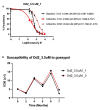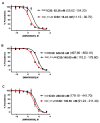Gossypol is a natural product with good antimalarial activity against Plasmodium falciparum clinical isolates
- PMID: 39789096
- PMCID: PMC11718166
- DOI: 10.1038/s41598-025-85643-6
Gossypol is a natural product with good antimalarial activity against Plasmodium falciparum clinical isolates
Abstract
Gossypol has demonstrated significant antimalarial activity against chloroquine-resistant and susceptible Plasmodium falciparum parasites. However, data on its potency in clinical isolates of P. falciparum remains limited. This study aimed to assess the potency of gossypol against six laboratory strains and twenty-one clinical isolates of P. falciparum using optimized growth inhibition assays. Additionally, parasites with reduced susceptibility to gossypol were selected using the P. falciparum Dd2 background (Dd2_3.5 µM) and tested for cross-resistance to chloroquine, dihydroartemisinin (DHA), and three Malaria box compounds (MMV006087, MMV085203, and MMV008956). On average, gossypol was found to be twice as potent against the laboratory strains compared to the clinical isolates, with IC₅₀ values of 6.490 µM and 11.670 µM, respectively. Notably, Dd2_3.5 µM parasites displayed increased sensitivity after three months of exposure but developed decreased susceptibility after six months. Importantly, these gossypol-tolerant parasites showed no cross-resistance to chloroquine, DHA, or the three Malaria box compounds. These findings suggest that gossypol is effective against P. falciparum and holds potential as part of combination therapy with existing antimalarials. Furthermore, these results may support the identification of new antimalarial agents that are effective against drug-resistant malaria parasites.
© 2025. The Author(s).
Conflict of interest statement
Declarations. Competing interests: The authors declare no competing interests.
Figures






Similar articles
-
Antimalarial activity of Malaria Box Compounds against Plasmodium falciparum clinical isolates.Int J Parasitol Drugs Drug Resist. 2017 Dec;7(3):399-406. doi: 10.1016/j.ijpddr.2017.10.005. Epub 2017 Oct 16. Int J Parasitol Drugs Drug Resist. 2017. PMID: 29128848 Free PMC article.
-
In vitro synergistic interaction of potent 4-aminoquinolines in combination with dihydroartemisinin against chloroquine-resistant Plasmodium falciparum.Acta Trop. 2019 Nov;199:105109. doi: 10.1016/j.actatropica.2019.105109. Epub 2019 Jul 24. Acta Trop. 2019. PMID: 31351071
-
Susceptibility of Plasmodium falciparum to artemisinins and Plasmodium vivax to chloroquine in Phuoc Chien Commune, Ninh Thuan Province, south-central Vietnam.Malar J. 2019 Jan 17;18(1):10. doi: 10.1186/s12936-019-2640-2. Malar J. 2019. PMID: 30654808 Free PMC article.
-
Molecular Mechanisms of Drug Resistance in Plasmodium falciparum Malaria.Annu Rev Microbiol. 2020 Sep 8;74:431-454. doi: 10.1146/annurev-micro-020518-115546. Annu Rev Microbiol. 2020. PMID: 32905757 Free PMC article. Review.
-
AQ-13 - an investigational antimalarial drug.Expert Opin Investig Drugs. 2019 Mar;28(3):217-222. doi: 10.1080/13543784.2019.1560419. Epub 2019 Jan 5. Expert Opin Investig Drugs. 2019. PMID: 30577704 Review.
Cited by
-
Harnessing Phytonanotechnology to Tackle Neglected Parasitic Diseases: Focus on Chagas Disease and Malaria.Pharmaceutics. 2025 Aug 12;17(8):1043. doi: 10.3390/pharmaceutics17081043. Pharmaceutics. 2025. PMID: 40871066 Free PMC article. Review.
References
-
- WHO. in WHO global malaria programme: world malaria report 2010 204–204. (2010).
-
- WHO. World Malaria Report 2014Vol. 23 (World Health Organization, 2014).
-
- Organization, W. H. World Malaria Report 2023 (World Health Organization, 2023).
-
- WHO. World malaria report 2019. Geneva: World Health Organization. Licence: CC BY-NC-SA 3.0 IGO. WHO (2019). (2019).
-
- WHO. World Malaria report 2015. Geneva: World Health Organization. WHO (2015). (2015).
Publication types
MeSH terms
Substances
Grants and funding
LinkOut - more resources
Full Text Sources

